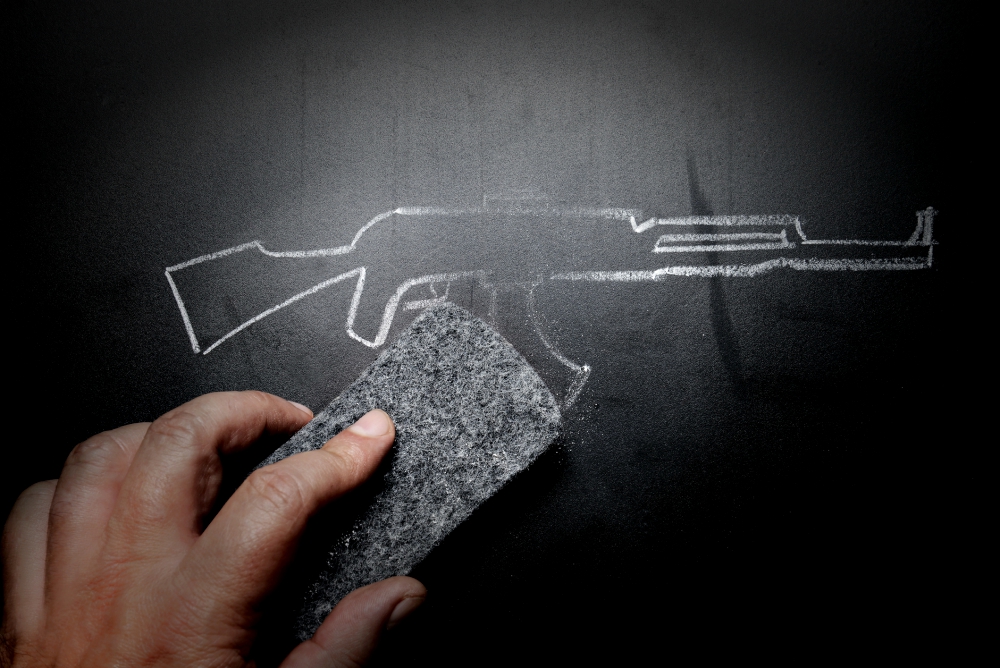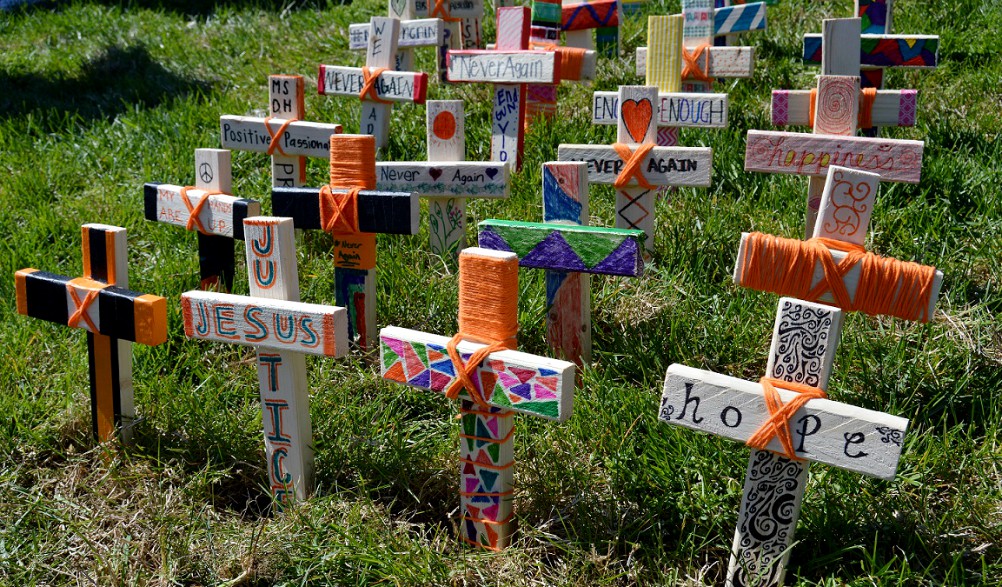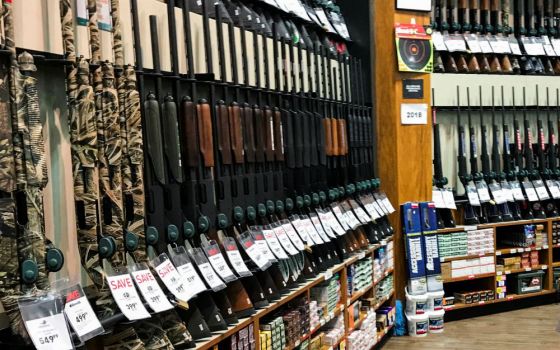
(Dreamstime/Claudio Gangi)
When Tom Walsh visited a parish in a small Texas town for Sunday Mass in November 2017, his experience was something out of a how-to guide for parish discipleship. Upon entering the little church, a married couple walked up to him, greeted him warmly and even asked what he — a stranger to the area — was doing in town. It was the sort of greeting one might associate with a faith community that is welcoming and intentional in its outreach.
But Walsh — a retired police detective who has helped corporations and public entities implement policies for protecting against acts of violence — saw the outreach for what it was.
"It was exactly like they used to train people in banks," he observed. This incident occurred within a couple weeks of the Sutherland Springs, Texas, church shooting, in which 27 people died. It made perfect sense to Walsh that a parish would be employing such a safety measure.
The mass shootings this summer in El Paso, Texas; Gilroy, California; and Dayton, Ohio, have once again drawn attention to how just about any gathering of people can be a target. And with churches and schools represented among the list of mass shooting targets going back more than 20 years, the imperative for Catholic institutions to prepare themselves is clear.
It can happen here
Heather Gossart, senior consultant at the National Catholic Educational Association, was president of Bishop McNamara High School in Maryland when the Columbine High School shooting occurred in Littleton, Colorado, in 1999.
"That was violence that happened somewhere else. That didn't happen to anyone we knew," she recalled of the reaction she and her colleagues had. "It's a mentality that we've got to get rid of."
The following year, the National Catholic Educational Association published a document, "Seeking Safer Schools," that asserted, "If we are to reduce the amount of dangerous behavior in our schools we, as teachers and administrators, will not accomplish that objective on our own. We need to do it in partnership — with students, parents, God, the community in general, and law enforcement in particular."

Students made these crosses as part of a "Day of Reflection for Peace" at Archbishop McNicholas High School in Cincinnati on April 20, 2018, which was the 19th anniversary of the school shooting at Columbine High School in Littleton, Colorado. (CNS/Archbishop McNicholas High School)
These partnerships also include the security and risk management firms that Catholic institutions enlist to help in their preparedness. "Whether it's a school or a church, they're going to be vulnerable," said Matt Dolan, a managing director for the firm Freeh Group International Solutions, noting that many perpetrators of mass shootings "have looked for crowds."
Dolan said the range of preparedness for such events includes physical security, such as access control and surveillance, as well as threat management programs, training and awareness, and having a plan in place to prevent or respond to an incident and deal with the post-incident challenges a school or church may face.
Dennis May, a former FBI agent who is now principal of a company that specializes in providing training and medical supplies to organizations, believes religious institutions represent a growing segment of the market for contractors that specialize in preparedness.
Dolan said that many schools have already engaged consultants and taken measures to mitigate risks, but that as technology improves, schools should continue to enlist consultants to see what works and what doesn't.
Gossart noted — from her own experience — that school administrators tend to give their schools high marks on security until an onsite assessment reveals the little vulnerabilities that can make a critical difference. She and Dolan agreed that there is no one-size-fits-all solution.
"What we certainly encourage our schools to do is to adopt reasonable kinds of precautionary procedures that are age-appropriate and are able to be carried out effectively," Gossart said. This would include age-appropriate training, which would vary as much as the difference between "a 200-pound football player and a group of 4-year-olds."
The small things
"We're going to work with the physical layout and the mission of that organization," Dolan said. Many institutions are apprehensive about the resources that might be required to meet the needs of preparedness, but a "layered approach" can ensure that there are numerous simple, low-cost and highly effective measures an organization can implement almost immediately. One example, Dolan said, would be to designate one person to watch the exits "while everyone is looking at the altar."
Advertisement
May, a Methodist who attends Mass with his kids, who are Catholic, agreed that having one person who knows "that's their job if something happens, I think you're a million steps ahead of where you were yesterday."
Other little fixes might include walkie-talkies for teachers or ingraining in students to never open an outer door to someone. But May focuses on the importance of training ordinary people to respond medically in the event of an incident. He noted that the shooting in Dayton lasted only a couple of minutes, but that "unfortunately, when any kind of event happens, the need for medical assistance is immediate."
This is where, he said, techniques to stop bleeding are essential. Otherwise, "people will perish that ordinarily wouldn't have to."
May's push for such measures reflects the reality that it's ultimately difficult to stop someone who is intent on harm. Gossart noted, "The emphasis needs to be on what do you do when your security has been breached."
"It doesn't matter if you're a police station, which is arguably very safe, or a church. Bad people can do bad things," May said. He added that a skill such as tying a tourniquet can be helpful in responding to everyday incidents, such as automobile and workplace accidents, that it doesn't have to be "the scary stuff."
Dolan offered another example of a Catholic school he once worked with that began the practice of inviting local law enforcement to visit for lunch once a week.
"The benefit was the police officers understood the layout of the campus, the buildings," Dolan said. "Over time you're going to build those relationships."
Cultural values
The good news for Catholic institutions is that safety and preparedness measures for dealing with mass shootings can be implemented in ways that are in accordance with, and even enhance, Catholic values — like warmly welcoming the stranger who walks into Mass or even knowing how to tend to the wounded.
"The gift that is given to our young people in our Catholic schools is the sense of safety and of belonging to family," said Gossart. She added that a prospect such as arming teachers would be antithetical to that sense of community. "You walk a fine line. You don't want to create armed fortresses in our Catholic schools."
"Most teachers I meet would give their lives for their students in an instant, but we're called upon to help create process and procedures that minimize the chances of someone being intrusive into our campuses," she added.
In terms of drills, sheltering in place and other preparation, May said it's understandable that people don't want to instill fear in students but, in reality, "these poor kids see everything on their phones."
May also sees the Catholic Church as ideally positioned for leading a widespread and positive culture shift.
"I look at churches as kind of the fundamental building block for education for morality," he said, recalling how his old boss at the FBI, also a Catholic, would cite the school system built by the church as such an infrastructure.
Gossart noted that perhaps the strongest protection offered by the identity and values of Catholic schools is "sense of caring for one another" that can stop a problem earlier, that if students, for instance, see one of their peers struggling, they will speak with a teacher or administrator long before it becomes a problem.
"We are called to look out for one another," she noted.
[Don Clemmer is a journalist, communications professional and former staffer of the U.S. Conference of Catholic Bishops. He writes from Indiana. Follow him on Twitter: @clemmer_don.]






